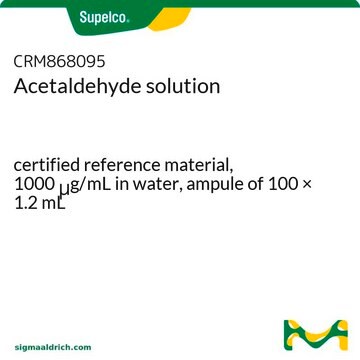W200387
Acetaldehyde solution
40 wt. % in isopropanol
About This Item
Prodotti consigliati
Origine biologica
synthetic
Livello qualitativo
Conformità normativa
FDA 21 CFR 117
FDA 21 CFR 182.60
Stato
liquid
Concentrazione
35.00-45.00% (titration by hydroxylamine)
40 wt. % in isopropanol
Punto di fusione
-123 °C
Densità
0.868 g/mL at 20 °C
applicazioni
flavors and fragrances
Documentazione
see Safety & Documentation for available documents
Allergene alimentare
no known allergens
Organolettico
pungent; ethereal; fruity
Temperatura di conservazione
2-8°C
Stringa SMILE
[H]C(C)=O
InChI
1S/C2H4O/c1-2-3/h2H,1H3
IKHGUXGNUITLKF-UHFFFAOYSA-N
Cerchi prodotti simili? Visita Guida al confronto tra prodotti
Categorie correlate
Esclusione di responsabilità
Avvertenze
Danger
Indicazioni di pericolo
Consigli di prudenza
Classi di pericolo
Carc. 1B - Eye Irrit. 2 - Flam. Liq. 1 - Muta. 2 - STOT SE 3
Organi bersaglio
Central nervous system, Respiratory system
Codice della classe di stoccaggio
3 - Flammable liquids
Classe di pericolosità dell'acqua (WGK)
WGK 3
Punto d’infiammabilità (°F)
-34.6 °F
Punto d’infiammabilità (°C)
-37 °C
Dispositivi di protezione individuale
Eyeshields, Faceshields, Gloves
Scegli una delle versioni più recenti:
Possiedi già questo prodotto?
I documenti relativi ai prodotti acquistati recentemente sono disponibili nell’Archivio dei documenti.
I clienti hanno visto anche
Global Trade Item Number
| SKU | GTIN |
|---|---|
| W200387-1KG | 4061837488887 |
| W200387-PZ | |
| W200387-SAMPLE |
Il team dei nostri ricercatori vanta grande esperienza in tutte le aree della ricerca quali Life Science, scienza dei materiali, sintesi chimica, cromatografia, discipline analitiche, ecc..
Contatta l'Assistenza Tecnica.






